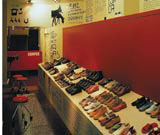Art and sold
Retail design is now using exhibition design techniques to make brands more appealing to consumers. Maeve Hosea looks at how this curatorial trend is transforming store environments

‘The store is all part of the creative environment of the brand,’ says the spokeswoman. ‘Innovation is always important and you can see that in the product,’ she adds. ‘We are not a fashion brand, we are a design brand and over the years we have become fashionable by coincidence.’
Using a variety of retail graphics including signs, bags, floor panels, posters and boxes, each store is an individual conceptual showcase for the brand.
A key component running through all designs is interaction between the product, the brand, the consumer and the space. In its three ‘info shops’ it uses the walls to relay messages about the brand in a style that is characteristic of a museum.
Recent Camper footwear creation Wabi, a shoe for interior use, claims to have achieved a highly ecological design through its use of materials and its manufacturing process. The Wabi store (Wabi is Japanese for peasant, as Camper derives from the Spanish for peasant) is opening in Milan in March or April 2005. As in other Camper stores, the walls, including graphic explanations about how Wabi works, will tell the story of the product. Like the shoe, it is designed to be a comfortable, cosy place where you can try them on.
Adidas/ Project X
Adidas’ Sports Performance Stores opened in London, Manchester and Birmingham in November 2004, and these are being followed up with an out-of-town Adicentre (DW 17 March). The approach is to guide consumers through the brand rather than explicity push product. ‘The concept is based around Adidas being the brand with the strongest sports heritage in terms of products designed specifically for sports performance,’ says Ross Haxton, a director at Project X, which designed the store. Divided into three key areas – Preparation, Competition and Recuperation – the stores are branded by a strong central Adidas stripe logo.
The theme for the store is the life of an athlete, relating back to the Adidas brand story. ‘The way that the product is laid out in terms of visual merchandising treats the products in an iconic way,’ says Haxton. Display systems, in the preparation area, for example, uses the sporting reference of weightlifting bars. A ‘decompression zone’ in the form of a tunnel-like area connecting the main store with the street outside divides the two worlds.
Intrepid/ The One Off
New travel store concept, Intrepid, which opens its first two stores in Melbourne and London in March and April 2005, wants to communicate its point of difference from mainstream tourism. ‘The experience is dramatised – not the brochure or some vague stereotypical family on holiday. The shop offers bespoke holidays, letting customers find what they want either rationally or emotionally,’ explains Adam Devey Smith at The One Off, the group that designed the stores.
An area of the store housing a map, a library and a noticeboard of travellers’ feedback gives customers the opportunity to get an honest, educated view of holiday destinations.
Instead of brochure racks, Intrepid presents the product through a pick and mix wall feature. Pictures and text cover the topics of style, culture shock, duration, physical grading, price and inspiration.
‘This style relaxes consumers,’ says Devey Smith. ‘As the brand and medium appear more concerned with communicating an idea or a concept than selling a pair of “whatevers”.’
Palmers/ Universal Design Studio
Universal Design Studio has designed retail interiors for expanding Austrian lingerie brand Palmers, providing it with a thematic backdrop to an eclectic mix of lingerie. A prototype of this concept was launched in the brand’s new concept store in Vienna in July 2004, and the brand is to be introduced to the UK later this year.
The design concept used gardens as inspiration. ‘We have the idea of a garden – either formal or wild – as a metaphor,’ says UDS director Jonathan Clarke. Gardens and all the different ways they have been approached over history are the overriding theme. Their characteristics of paths, routes and vistas mix with plant types, heights and structures. ‘We didn’t want to dilute the brand,’ he says. ‘The theme always gives it something to talk about and can potentially be applied to all of its 300 stores, whether it is 10m2 or 300m2.’
-
Post a comment



